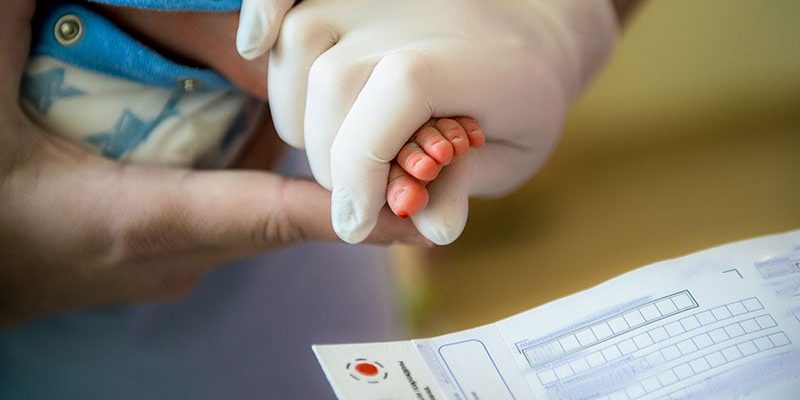Despite their convenience and low cost, handheld point-of-care (POC) devices lack precision for measuring neonatal bilirubin and need refinement in order to tailor jaundice management in newborns, a systematic review and meta-analysis reports in JAMA Pediatrics. Lauren E.H. Westenberg, MD, of the division of neonatology at Erasmus MC Sophia Children’s Hospital in Rotterdam, the Netherlands, and colleagues reported that POC meters tended to underestimate neonatal bilirubin levels, compared with conventional laboratory-based quantification.
Furthermore, pooled estimates from 10 studies found these devices to be too imprecise overall, with substantial outer-confidence bounds. On the plus side, Dr. Westenberg’s group said POC bilirubin testing was as much as 60 times faster than lab measurement, and used 40-60 times less blood. “Conventional laboratory-based bilirubin quantification usually requires up to 500 mcL, but sometimes even 1,500 mcL, while POC tests require up to 50 mcL, which means less stress for the baby,” Dr. Westenberg said in an interview. “Especially when infants are cared for at home, it usually takes a few hours between deciding to quantify bilirubin and obtaining the test result. Meanwhile, bilirubin levels may rise unnoticed.”
On the positive side, POC devices are useful where laboratories in low-resource areas may be remote, poorly equipped, and not always able to provide an accurate bilirubin level. “As a result, the diagnosis of jaundice relies mainly on visual inspection, which is known to be unreliable,” she said. POC devices, however, need near-perfect conditions for optimal use, and results can be affected by humidity, preanalytic conditions such as test strip saturation, and hematocrit.
Yet results from these devices have recently proven to have acceptable accuracy, resulting, for example, in the same clinical decisions as the reference standard in 90.7% of times according to a 2022 study in a hospital in Malawi.
Nevertheless, the authors concluded that the devices’ imprecision limits their widespread use in neonatal jaundice management, especially when accurate lab-based bilirubin quantification is available. Results from these POC tests should be interpreted with caution, Dr. Westenberg said. In terms of clinical decision-making, POC devices entail a risk of missing neonates with jaundice who need phototherapy or, in the case of overestimation, of starting phototherapy too early.
The study
The meta-analysis included nine cross-sectional and one prospective cohort study representing 3,122 neonates in Europe, Africa, and East and Southeast Asia. Two tests with 30-minute turnaround times were evaluated in neonates 0-28 days old. The Bilistick device was evaluated in eight studies and the BiliSpec (now called BiliDX) in just two studies. Three of the studies had a high risk of bias.
A total of 3,122 measurements paired with lab quantification showed a pooled mean difference in total bilirubin levels for the POC devices of –14 micromol/L, with pooled 95% confidence bounds (CBs) of –106 to 78 micromol/L. For the Bilistick, the pooled mean difference was –17 micromol/L (95% CBs, –114 to 80 micromol/L). Of the two devices, the Bilistick was more likely to have a failed quantification against the reference standard.
Context for POC devices
Commenting on the meta-analysis but not involved in it, Rebecca Richards-Kortum, PhD, a professor of biomedical engineering at Rice University in Houston, noted that both devices were developed specifically to address needs in low-resource settings. “I don’t think the meta-analysis acknowledges this rationale sufficiently,” she said. “It feels like this paper is comparing apples to oranges and then criticizing the apples for not being oranges,” said Dr. Richards-Kortum, who helped develop the BiliSpec test.
Similarly, Anne S. Lee, MD, MPH, an associate professor of pediatrics at Brigham and Women’s Hospital in Boston, and not a participant in the meta-analysis, also stressed that POC devices are designed for scenarios where lab-based results are not widely available. “In a broad sense, the devices fill an important gap, both in low- and middle-income countries, as well as in the U.S. when laboratory capacity is not readily available,” said Dr. Lee. She was involved the development of the Bili-ruler icterometer, which proved to be diagnostically accurate in Bangladeshi newborns.
“Access to this technology is a critical way to address health disparities even in the U.S.,” Dr. Lee continued. “We have heard of the need for this technology from the Indian health services and Alaskan health services, where decisions are made to airlift a child based on a visual inspection alone.”
More broadly, however, cautioned Dr. Westenberg, the total allowable error and the permissible limits of uncertainty in neonatal bilirubin quantification need to be defined – irrespective of the method used. “Accurate measurement of bilirubin is difficult as has been demonstrated in so-called external quality assessment (EQA) programs that exist for laboratory-based bilirubin methods,” she said. “EQA programs for POC bilirubin devices that include a reference method as a gold standard may contribute to adaptation of the device and improving POC test imprecision.”
This work was supported by the Netherlands Organization for Health Research and Development. The authors had no conflicts of interest to disclose. Dr. Richards-Kortum and Dr. Lee have both been involved in the development of POC devices for assessing neonatal bilirubin levels.
This article originally appeared on MDedge.com, part of the Medscape Professional Network.
Source: Read Full Article
